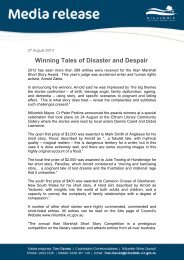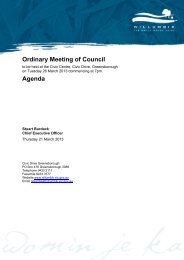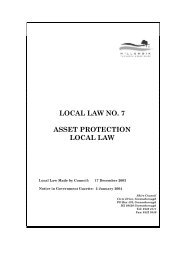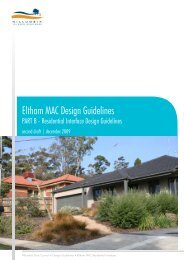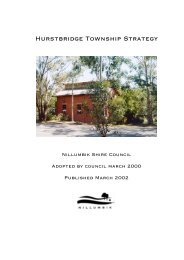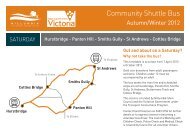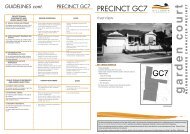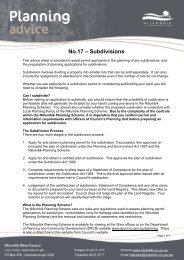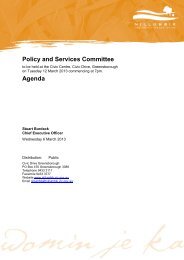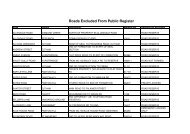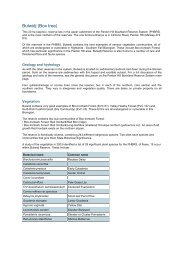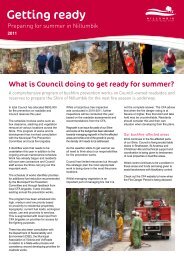Municipal Fire Management Plan 2013â2016 - Nillumbik Shire ...
Municipal Fire Management Plan 2013â2016 - Nillumbik Shire ...
Municipal Fire Management Plan 2013â2016 - Nillumbik Shire ...
You also want an ePaper? Increase the reach of your titles
YUMPU automatically turns print PDFs into web optimized ePapers that Google loves.
<strong>Municipal</strong> <strong>Fire</strong> <strong>Management</strong> <strong>Plan</strong> 2013–2016 (Draft)<strong>Nillumbik</strong>
ForewordCharacterised by diverse topographies, <strong>Nillumbik</strong> ranges from gentle undulating slopes to very steep andheavily treed areas, with a number of nature and recreation reserves throughout the municipality. <strong>Nillumbik</strong> iscovered by vegetation, environmental and landscape-based overlays, which seek to protect nativevegetation. A Green Wedge covers the municipality supporting a diverse range of species and their habitats.It is home to 1,000 indigenous flora species, 64 of which are listed significant species.The <strong>Nillumbik</strong> <strong>Municipal</strong> <strong>Fire</strong> <strong>Management</strong> <strong>Plan</strong> is a sub plan of the <strong>Nillumbik</strong> <strong>Municipal</strong> Emergency<strong>Management</strong> <strong>Plan</strong> and is deemed to meet the requirements for the development of a <strong>Municipal</strong> <strong>Fire</strong>Prevention <strong>Plan</strong> under the Country <strong>Fire</strong> Authority Act 1958.The primary objective of municipal fire management planning is the protection of life. It is a coordinatedapproach of key agencies involved in managing the risk of fire to plan and manage fire in thecommunity by adhering to a key tenet of emergency planning—Prevention, Preparedness, Response andRecovery. Stakeholders contribute knowledge, experience, resources and capability and aim to achievemeasurable fire management outcomes through agreed and achievable risk treatments.This document can be found at www.nillumbik.vic.gov.au.AcknowledgementsThe <strong>Municipal</strong> <strong>Fire</strong> <strong>Management</strong> <strong>Plan</strong>ning Committee acknowledges the contributions of the followingagencies and organisations:• <strong>Nillumbik</strong> <strong>Shire</strong> Council• Country <strong>Fire</strong> Authority• Metropolitan <strong>Fire</strong> Brigade• Department of Sustainability and Environment/Parks Victoria• Victoria Police• VicRoads• SP Ausnet• Melbourne Water• Department of Human Services<strong>Nillumbik</strong> <strong>Municipal</strong> <strong>Fire</strong> <strong>Management</strong> <strong>Plan</strong> 2013–2016
Authorisation and EndorsementThis first edition of the <strong>Nillumbik</strong> <strong>Municipal</strong> <strong>Fire</strong> <strong>Management</strong> <strong>Plan</strong> was endorsed by the <strong>Municipal</strong> <strong>Fire</strong><strong>Management</strong> <strong>Plan</strong>ning Committee in September 2012. Organisations represented on the committee include:• <strong>Nillumbik</strong> <strong>Shire</strong> Council• Country <strong>Fire</strong> Authority• Metropolitan <strong>Fire</strong> Brigade• Department of Sustainability and Environment/Parks Victoria• Victoria Police• VicRoads• Melbourne Water• Department of Human ServicesThis <strong>Municipal</strong> <strong>Fire</strong> <strong>Management</strong> <strong>Plan</strong> was also endorsed by the <strong>Nillumbik</strong> <strong>Municipal</strong> Emergency<strong>Management</strong> <strong>Plan</strong>ning Committee in September 2012 and adopted by Council as a sub-plan of the <strong>Nillumbik</strong><strong>Municipal</strong> Emergency <strong>Management</strong> <strong>Plan</strong> in [insert date].<strong>Nillumbik</strong> <strong>Municipal</strong> <strong>Fire</strong> <strong>Management</strong> <strong>Plan</strong> 2013–2016
TABLE OF CONTENTS1 INTRODUCTION AND CONTEXT .................................................................................. 6What is IFMP? ..................................................................................................................................6Authority for the plan.........................................................................................................................6Purpose of this <strong>Plan</strong>..........................................................................................................................6Membership of <strong>Nillumbik</strong> <strong>Municipal</strong> <strong>Fire</strong> <strong>Management</strong> Committee ..................................................7Role of <strong>Nillumbik</strong> <strong>Municipal</strong> <strong>Fire</strong> <strong>Management</strong> Committee...............................................................7Working Groups ................................................................................................................................82 ENGAGEMENT AND COMMUNICATIONS .................................................................... 83 ENVIRONMENTAL SCAN .............................................................................................. 8<strong>Nillumbik</strong> <strong>Shire</strong> Council Profile .........................................................................................................8<strong>Fire</strong> History .......................................................................................................................................9Structural <strong>Fire</strong>s .............................................................................................................................. 104 MUNICIPAL FIRE MANAGEMENT OBJECTIVES ....................................................... 10<strong>Plan</strong> Objectives .............................................................................................................................. 10Alignment to Regional Objectives .................................................................................................. 105 FIRE MANAGEMENT STRATEGIES ............................................................................ 11Risk Tools and Guides................................................................................................................... 126 PLAN REPORTING AND REVIEW ............................................................................... 13<strong>Plan</strong> Endorsement ......................................................................................................................... 13Audit ............................................................................................................................................... 14<strong>Plan</strong> Review ................................................................................................................................... 147 APPENDICES ............................................................................................................... 15A MFMPC ACTION PLAN .................................................................................... 15B RISK MANAGEMENT REGISTER .................................................................... 16Bush and Grass <strong>Fire</strong> Risk <strong>Management</strong> Register .............................................. 16Structure <strong>Fire</strong> Risk Asset Table ......................................................................... 16C STATUTORY AUDIT OBLIGATIONS................................................................ 17C.1 Hazardous Trees ....................................................................................................... 17C.2 Neighbourhood Safer Places (NSP) .......................................................................... 20C.3 Community <strong>Fire</strong> Refuges ........................................................................................... 20D COMMUNITY INFORMATION GUIDES ............................................................ 21E METHODOLOGY FOR PRIORITISING WORKS ON ROADSIDES .................. 22F MAPS ................................................................................................................ 32G RESPONSE PLANS .......................................................................................... 33H RECOVERY PLANS .......................................................................................... 33I PRECINCT (LANDSCAPE) PLANS .................................................................. 33Plenty Gorge Integrated <strong>Fire</strong> Prevention Strategy ........................................................... 33<strong>Nillumbik</strong> <strong>Municipal</strong> <strong>Fire</strong> <strong>Management</strong> <strong>Plan</strong> 2013–2016
J PROPOSED FIRE ACCESS ROADS SUBSIDY SCHEME (FARRS)PROJECTS ....................................................................................................... 34K PROPOSED BURN SCHEDULES .................................................................... 37L ACRONYMS USED IN THIS PLAN ................................................................... 39M BIBLIOGRAPHY ............................................................................................... 40Attachment 1 - Stakeholder Analysis ............................................................................................. 41Attachment 2 – Brigade Working Group Terms of Reference ....................................................... 42Attachment 3 – Community Engagement <strong>Plan</strong> ............................................................................. 45<strong>Nillumbik</strong> <strong>Municipal</strong> <strong>Fire</strong> <strong>Management</strong> <strong>Plan</strong> 2013–2016
1. INTRODUCTION AND CONTEXTWhat is Integrated <strong>Fire</strong> <strong>Management</strong> <strong>Plan</strong>ning?Integrated <strong>Fire</strong> <strong>Management</strong> <strong>Plan</strong>ning is an all-agency planning approach to managing the fire riskacross the State of Victoria, with planning occurring at three levels—State, Regional and <strong>Municipal</strong>.<strong>Nillumbik</strong> is a member of the Northern and Western Metropolitan Regional Strategic <strong>Fire</strong> <strong>Management</strong><strong>Plan</strong>ning Committee (‗NWM RSFMPC‘)—one of eight regional committees operating across Victoria.At a municipal level it is a forum to ―build and sustain organisational partnerships, generate a commonunderstanding and shared purpose with regard to fire management and ensure that plans of individualagencies are linked and complement each other.‖(Integrated <strong>Fire</strong> <strong>Management</strong> <strong>Plan</strong>ning Guide,2010).The <strong>Municipal</strong> <strong>Fire</strong> <strong>Management</strong> <strong>Plan</strong> (MFMP) is risk based and has been developed using theprinciples outlined in the Integrated <strong>Fire</strong> <strong>Management</strong> <strong>Plan</strong>ning (IFMP) Framework and Guide, andthe Guidelines for <strong>Municipal</strong> <strong>Fire</strong> <strong>Management</strong> <strong>Plan</strong>ning, Part 6A: Emergency <strong>Management</strong> ManualVictoria.The development of this plan has also been influenced by the National Strategy for DisasterResilience. This has been adopted at a national level as a ―resilience-based approach to disastermanagement….. Application of a resilience-based approach is not solely the domain of emergencymanagement agencies; rather, it is a shared responsibility between governments, communities,businesses and individuals.‖ (COaG, 2009)Sections 1 through to 6 of this <strong>Plan</strong> contain an overview of the municipal district, fire managementobjectives, and plan reporting and review.A separate Appendices section provides detail on risk identification treatment options, statutoryobligations, mapping and community engagement. Mapping forms a significant part of this <strong>Plan</strong>,providing a visual representation of the local fire risk.Contents of the Appendices section will evolve as risk-based processes and tools are refined andbusiness plans aligned accordingly.Authority for the planThis <strong>Municipal</strong> <strong>Fire</strong> <strong>Management</strong> <strong>Plan</strong> (MFMP) has been produced by and with the authority of the<strong>Nillumbik</strong> <strong>Shire</strong> Council pursuant to Section 20 of the Emergency <strong>Management</strong> Act 1986; and will bedeemed to fulfil Section 55A of the CFA Act 1958. The development and implementation of theMFMP sits with the MFMPC and corresponding agencies. The MFMP is a sub plan of the <strong>Nillumbik</strong><strong>Shire</strong> Council <strong>Municipal</strong> Emergency <strong>Management</strong> <strong>Plan</strong> (MEMP). MFMP‘s have a three year planningcycle being reviewed on a 12 month basis from the endorsement of the plan.Purpose of the <strong>Plan</strong>The purpose of the <strong>Nillumbik</strong> <strong>Municipal</strong> <strong>Fire</strong> <strong>Management</strong> <strong>Plan</strong> is to address potential fire threats onboth public and private land across the prevention, preparedness, response and recovery spectrum.The <strong>Plan</strong> will be reviewed and updated each year to incorporate any new strategies, programs andtools developed by the State <strong>Fire</strong> <strong>Management</strong> <strong>Plan</strong>ning Committee (SFMPC)—and to ensure itmeets stakeholder and community needs and expectations.This plan scopes and provides treatment options to reduce the risk of fire, yet will not eliminate all risk.<strong>Nillumbik</strong> communities must acknowledge they will continue to reside in high fire prone areas. Thereare a number of localities within the <strong>Shire</strong> rated Very High to Severe, even when all availabletreatment options have been applied. During a fire event, property loss is inevitable and loss of lifepossible. Living in these areas requires an acceptance of this risk.<strong>Nillumbik</strong> <strong>Municipal</strong> <strong>Fire</strong> <strong>Management</strong> <strong>Plan</strong> 2013-2016 Page 6
It is actions taken at a community and individual level that will have the biggest impact on reducingthe risk from fire; not the actions of the agencies responsible for this plan.Membership of the <strong>Nillumbik</strong> <strong>Fire</strong> <strong>Management</strong> <strong>Plan</strong>ning CommitteeThe <strong>Municipal</strong> <strong>Fire</strong> <strong>Management</strong> <strong>Plan</strong>ning Committee (MFMPC), appointed by the <strong>Municipal</strong>Emergency <strong>Management</strong> <strong>Plan</strong>ning Committee (MEMPC), has representation from the followingorganisations:• <strong>Nillumbik</strong> <strong>Shire</strong> Council• Country <strong>Fire</strong> Authority• Department of Sustainability and Environment/Parks Victoria• Metropolitan <strong>Fire</strong> Brigade• Victoria Police• VicRoads• Department of Human Services• Metro Trains• Melbourne Water• Other members as requiredRole of the <strong>Nillumbik</strong> <strong>Fire</strong> <strong>Management</strong> <strong>Plan</strong>ning CommitteeThe Committee‘s purpose, of which the development of a municipal fire management plan is part, isto provide a municipal-level forum to build and sustain organisational partnerships, generate acommon understanding and shared purpose with regard to fire management and ensure that theplans of individual agencies are linked and complement each other.The role of the Committee is:identifying and prioritising the risks and vulnerabilities across the municipalityreducing the likelihood and consequence of fire hazards within local communitiesdevelopment and implementation of works programs for the management of fires, includinghazard removal and fuel managementprovide information to and engage with the community on matters related to fire managementplanningidentification of reliable water suppliesencourage responsibility by the communityconsideration of planning across municipal boundariesplan for fire management in a manner that coordinates cooperative fire management activitiesacross agenciesmonitor, review and report on the delivery of the MFMPadvocate to the RSFMPC for municipal fire management needswork with the MEMPC to align planning activitiesshare knowledge and create an environment of continuous improvementBy participating in this process, all agencies involved have provided a commitment to undertakethe works detailed in this <strong>Plan</strong>.<strong>Nillumbik</strong> <strong>Municipal</strong> <strong>Fire</strong> <strong>Management</strong> <strong>Plan</strong> 2013-2016 Page 7
Working GroupsThe MEMPC or MFMPC may from time to time appoint working groups to assist with fire managementplanning. The MEMPC has endorsed a working group made up of the 13 local brigades‘representatives and others as required. The purpose of this group is to ensure that the MFMPC isinformed by local knowledge. The working group will report to the MEMPC through the CFAdelegates on the MFMPC. (For more information on the Working Group, see Attachment 2 of thisdocument: Terms of Reference, Brigade Working Group).2 ENGAGEMENT AND COMMUNICATIONSA requirement of the <strong>Nillumbik</strong> <strong>Shire</strong> Council <strong>Municipal</strong> <strong>Fire</strong> <strong>Management</strong> <strong>Plan</strong> is the development ofa Stakeholder Engagement and Communications <strong>Plan</strong> (see Attachment 3 of this document) to guidehow fire management objectives and outcomes are communicated both to stakeholders and to thebroader community.Community Engagement is guided by the International Association for Public Participation (IAP2)community engagement model, which is a framework for planning effective communication andengagement on any issue or plan.Using the IAP2 framework model, it‘s important that stakeholders understand and appreciate thegoals and objectives of fire management planning. By clearly communicating these objectives,stakeholders will ‗own‘ the <strong>Plan</strong> and make positive contributions both to the <strong>Plan</strong> and the Committee.A stakeholder consultation plan and process has been developed for the successful development andimplementation of this <strong>Plan</strong>. Stakeholders involved in fire management planning in the <strong>Nillumbik</strong><strong>Shire</strong> Council have been listed in this <strong>Plan</strong> (see Attachment 2: Stakeholder Analysis) and their level ofparticipation and involvement noted.3 ENVIRONMENTAL SCAN<strong>Nillumbik</strong> <strong>Municipal</strong> ProfileLocated 25 kilometres northeast of Melbourne, the municipality of <strong>Nillumbik</strong> covers 431.94 squarekilometres, and has an estimated population of 64,219. The most southerly point is bound by theYarra River and is characterised by predominately urbanised residential allotments, including Eltham,Hurstbridge and Diamond Creek. It extends 29 kilometres north to Kinglake National Park andstretches approximately 20 kilometres from the Plenty River and Yan Yean Road in the west toChristmas Hills, and the Yarra escarpment in the east, all characterised by an urban-rural interface.The municipality includes a wide variety of topographies, ranging from gentle undulating slopes atKangaroo Ground to very steep and heavily treed areas around Plenty Gorge, North Warrandyte andthe Kinglake National Park. There are over 828 hectares of nature and recreation reserves within themunicipality. Ground cover in grassland areas is generally medium to heavy depending on the extentof grazing.<strong>Nillumbik</strong> is covered by vegetation, environmental and landscape-based overlays, which seek toprotect native vegetation. The <strong>Nillumbik</strong> Green Wedge covers 91 per cent of the municipality, yetwhilst the municipality of <strong>Nillumbik</strong> is referred to as the ‗Green Wedge <strong>Shire</strong>‘; in Land Use <strong>Plan</strong>ningterms, green wedge land is defined as being outside the urban growth boundary. The <strong>Nillumbik</strong>Green Wedge supports a diverse range of species and their habitats. It is home to 1,000 indigenousflora species, 64 of which are listed significant species.The <strong>Nillumbik</strong> Green Wedge is in the catchment of the Yarra River and is bordered by the PlentyRiver in the west and the Yarra River to the south and south-east. Apart from natural waterways, the<strong>Nillumbik</strong> Green Wedge is the location for key parts of Melbourne‘s infrastructure for potable waterstorage. As a result, the development pattern across the municipality is one that consists of dwellings<strong>Nillumbik</strong> <strong>Municipal</strong> <strong>Fire</strong> <strong>Management</strong> <strong>Plan</strong> 2013-2016 Page 8
located in environmentally significant landscapes susceptible to bushfires and often connected tosingle access roads.Within the rural areas of the municipality, there are a number of communities with restricted accessand egress. This is due to the pattern of existing roads (both minor unsealed access roads and majorarterial roads), being predominantly single carriageways that follow the topography and landscape, incombination with extensive roadside vegetation. This creates a unique challenge in planning fireprevention programs. There are additional concerns relating to the ability of priority road networks toaccommodate the evacuation of an area‘s population during a fire event, and emergency fire fightingvehicles and police being unable to respond in certain areas and under certain conditions.The majority of the green wedge area of <strong>Nillumbik</strong> falls into a designated Bushfire Prone Area(BPA)—a statewide building control with specific bushfire construction standards aimed at improvingbushfire protection for residential buildings.In addition to BPA, parts of <strong>Nillumbik</strong> fall under the Bushfire <strong>Management</strong> Overlay (BMO), a statewideplanning control that considers localities with highest exposure to bushfire risk. Any development inthese areas must contain the appropriate bushfire protection measures before any development canproceed.More details on the BPA and BMP can be found at www.dpcd.vic.gov.au/planningschemes.<strong>Fire</strong> HistoryBushfire seasons are generally restricted to the summer months during late December–February.The <strong>Fire</strong> Danger Period (FDP) is therefore introduced to reduce the risk of fire, and enforced generallyfrom November to early April depending on weather conditions.Over the past 70 years there have been a number of major fires throughout the <strong>Municipal</strong>ity that haveresulted in the loss of life and property.Most recently, the February 2009 Black Saturday fires saw the municipality experience the mostdevastating and damaging fires in history in the Strathewen, St Andrews and Christmas Hills areas.This fire led to extensive life and property losses. There have also been a number of other fires thathave had a significant impact on the local area.Years of Significance:1939 – <strong>Fire</strong>s in Strathewen1957 – <strong>Fire</strong>s impacted from Plenty down into Greensborough1962 – Major fire front from St Andrews through to Warrandyte & Wonga Park1964 – Plenty Gorge Area1969 – Diamond Creek through to Research and Warrandyte1978 – Plenty Gorge Area1980 – Plenty Gorge Area1990 – Plenty Gorge Area1991 – Pound Bend (Warrandyte)2009 – Black Saturday <strong>Fire</strong>s<strong>Nillumbik</strong> <strong>Municipal</strong> <strong>Fire</strong> <strong>Management</strong> <strong>Plan</strong> 2013-2016 Page 9
Structural <strong>Fire</strong>sIn common with other municipalities, the municipality has also experienced significantstructural/residential fires in recent history. Unlike neighbouring municipalities, <strong>Nillumbik</strong> lacks largeindustrial areas but does have a major hazard facility—the Winneke Water Treatment <strong>Plan</strong>t.4 MUNICIPAL FIRE MANAGEMENT OBJECTIVES<strong>Plan</strong> ObjectiveThe primary objective of the <strong>Nillumbik</strong> <strong>Municipal</strong> <strong>Fire</strong> <strong>Management</strong> <strong>Plan</strong> is the protection of human lifefrom the threat of fire followed by the protection of critical infrastructure; protection of property andeconomic assets; and the protection of environmental and cultural values.To achieve this, the <strong>Nillumbik</strong> MFMPC will work together in a coordinated manner to discuss, planand manage fire in the community across the Prevention, Preparedness, Response and Recoveryspectrum. Stakeholders will contribute knowledge, experience, resources and capability and aim toachieve measurable fire management outcomes through agreed and achievable risk treatments.across an all hazards environment (bush and grass fire and structure).It is important to note that over 80 percent of land in <strong>Nillumbik</strong> is privately held (see graph below),constraining the ability of agencies to directly manage vegetation in certain areas. It is therefore therole of agencies to influence property owners to undertake fire planning on their properties throughinitiatives like CFAs Home Bushfire Advice Service and Community <strong>Fire</strong>guard and joint educationcampaigns before and during every fire season.Percentage of Land Tenure9080706050Percentage of Land Tenure403020100Crown Lands 5.88%, 2541.52haMW, YVW and VicTrack5.96%, 2575.11 ha<strong>Nillumbik</strong> SC 7.15%,30587.43 haPrivate Ownership 81.01%,34996.63 haAlignment to Regional objectivesThe <strong>Nillumbik</strong> <strong>Municipal</strong> <strong>Fire</strong> <strong>Management</strong> <strong>Plan</strong> is guided by the objectives and actions containedwithin the Northern and Western Metropolitan Regional Strategic <strong>Fire</strong> <strong>Management</strong> <strong>Plan</strong> 2011 (pages15-22).These objectives are categorised according to five themes, with several underlying strategies andactions driving each objective. These themes are:• Develop regional, municipal and local fire management planning arrangements with a clearpurpose and a consistent assessment of risk.• Develop and implement fire management programs and activities in a collaborative manner.<strong>Nillumbik</strong> <strong>Municipal</strong> <strong>Fire</strong> <strong>Management</strong> <strong>Plan</strong> 2013-2016 Page 10
• Build and share knowledge in the fire management sector and across the community.• Improve the capability of communities, the fire management sector and the region to deal withfires.• Using fire to manage fuels and support the health of natural, social and economicenvironments.All of the actions have broad outcomes and agency accountabilities attached to them and a timeframefor when they will be achieved.5 FIRE MANAGEMNET STRATEGIESThe <strong>Nillumbik</strong> <strong>Municipal</strong> <strong>Fire</strong> <strong>Management</strong> <strong>Plan</strong>ning Committee will use the following strategies tomeet the objectives of this plan:Identify, analyse and treat fire risk by utilising best practise methodology as described byAS/NZS ISO 31000:2009.build and support community resilience in <strong>Nillumbik</strong>‘s high bushfire risk environment bydeveloping programs to effectively engage with the community and promote local communityand individual planning.develop sustainable risk mitigation programs; this will be achieved by continually reviewingthe effectiveness of mitigation programs and advocating for additional funding where requiredprograms cannot be funded locally.ensure that <strong>Municipal</strong> planning objectives are aligned to regional fire management planningobjectives; will be achieved by reviewing local plans and active participation in the regionalplanning process.<strong>Nillumbik</strong> <strong>Municipal</strong> <strong>Fire</strong> <strong>Management</strong> <strong>Plan</strong> 2013-2016 Page 11
Risk Tools and GuidesThe <strong>Nillumbik</strong> MFMPC will utilise best practice models of risk management to inform this plan. Yet noone risk management tool or combination of tools will be enough to manage the fire risk in <strong>Nillumbik</strong>.Effective fire management will require the input of local knowledge attained from committee andcommunity members.The <strong>Municipal</strong> <strong>Fire</strong> <strong>Management</strong> <strong>Plan</strong>ning Committees have utilised tools based on ISO 31000: 2009to inform this plan. These tools include:The Community Emergency Risk <strong>Management</strong> ‘CERM’This is a method of managing <strong>Municipal</strong> wide risks.structural fire as being significant risks in <strong>Nillumbik</strong>.This process has identified bushfire andThe Victoria State Emergency Service is currently reviewing and improving this process, which infuture will be known as Community Emergency Risk Assessment (CERA). Members of the <strong>Nillumbik</strong>MEMPC are involved in the development of this tool.Further information can be found at http://www.ses.vic.gov.au/.Victorian <strong>Fire</strong> Risk RegisterThe VFRR is a systematic process that utilises the expertise and local knowledge of a range oforganisations and stakeholders in identifying locations and assets at risk from bush or grass fires,then assessing the level of risk and assigning a range of treatments to manage / mitigate the risk.Stakeholders include representatives from Council, CFA, MFB, Parks Victoria, Department ofSustainability and Environment, Victoria Police, Melbourne Water and others.Under the VFRR process, assets are grouped into several broad categories—Human Settlement,Economic, Environmental and Cultural Heritage and include residential and commercial properties atrisk of bushfire; key infrastructure such as transmission lines, communication towers and waterstorage facilities; and any environmental or cultural assets.Within each asset category, are the following sub-categories:Asset CategoryHuman SettlementEconomicEnvironmentalCultural HeritageAsset sub-categoryResidential, Special <strong>Fire</strong> Protection, OtherAgriculture, Commercial , Infrastructure, Tourist & Recreational, MinesCommercial Forests, Drinking Water CatchmentsLocally Important, Endangered, VulnerableAboriginal Significance, Non Indigenous, OtherUnder each category, locations and assets are identified and their level of risk assessed based on arange of inputs including proximity to flammable vegetation; vegetation type; slope, frequency of fires;and the probability of a fire igniting on an extreme fire danger day with a fire danger index rating of100 or more.The VFRR broadly considers the impact of ember attack on property. Embers mostly occur close tothe source of a fire, and are the result of wind-borne burning vegetation being carried away fromflames before it is fully combusted.Research has shown that embers will travel between 50 and 300 metres ahead of the fire front(McAneney, J. and Chen, K, 2010) and that any impact on the more urbanised parts of themunicipality is minimal. Ember attack is more likely when communities are located within 200 metresof native vegetation/forest.The <strong>Nillumbik</strong> <strong>Fire</strong> <strong>Management</strong> <strong>Plan</strong> has focused on VFRR assessments in the Human Settlementcategory. Future revisions will consider the impacts of fire in the economic, environmental andcultural categories.<strong>Nillumbik</strong> <strong>Municipal</strong> <strong>Fire</strong> <strong>Management</strong> <strong>Plan</strong> 2013-2016 Page 12
The primary output of the VFRR is a Bushfire Risk Register table. This contains the risk assessmentsfor a specific location/asset with risk descriptors of low, medium, high, very high and extreme. TheRegister also assigns a priority risk rating to each asset to assist in prioritising risk treatments. Thehighest priority risk is given 1A rating, the lowest a rating of NA (Need for action is unlikely).VFRR also provides a list of treatment/mitigation actions per each asset location (along with theresponsible agency). Treatments may include prevention works such as fuel reduction burning,roadside vegetation management, grass slashing and property inspections or fire preparednessinitiatives—such as development of personal bushfire plans, use of CFA‘s Home Bushfire AdviceService and provision of fire safety information through the media and the fire agencies during thesummer fire season.Complementing this work, VFRR output maps are available to inform and provide a spatial overviewof localities with an identified bushfire risk.All this information is then complied and inserted into a Multi-agency Workplan, a ‗live‘ documentdetailing all agency works /treatments against the identified risks.It is then the role of the <strong>Municipal</strong> <strong>Fire</strong> <strong>Management</strong> Committee to review the Workplan and determineif the risk ratings are appropriate or if new assets need to be identified and placed on the Register. Italso considers all treatment/mitigation works to determine if they are suitable or if additional worksneed to be undertaken.Code of Practice for Bushfire <strong>Management</strong> on Public Land (DSE 2012)The Code of Practice for Bushfire <strong>Management</strong> on Public Land establishes the framework for bushfiremanagement (including planned burning and bushfire response) on Victoria's public land.Roadside Vegetation <strong>Management</strong> for Bushfire Risk Mitigation Purposes (DSE 2012)The purpose of this guideline is to assist VicRoads and local councils to determine if works involvingthe removal of native vegetation for bushfire mitigation are exempt from planning schemerequirements under clause 58.02 of the Victoria <strong>Plan</strong>ning Provisions (Roadside Works for BushfirePurposes). The guideline is also designed to assist road mangers to work through a risk assessmentprocess as required by the new exemption.Further information can be found on the Department of Sustainability and Environment website athttp://www.dse.vic.gov.au/.6 PLAN REPORTING AND REVIEW<strong>Plan</strong> EndorsementThe <strong>Nillumbik</strong> <strong>Municipal</strong> <strong>Fire</strong> <strong>Management</strong> Committee is the custodian of the <strong>Municipal</strong> <strong>Fire</strong><strong>Management</strong> <strong>Plan</strong> pursuant to current legislative arrangements.The MFMPC shall draft a MFMP and seek endorsement, by signature, of the draft plan from thecommittee and, where appropriate, non-committee members with responsibilities and accountabilitiesunder the <strong>Plan</strong>. Following this process, the MFMPC will recommend the MFMP to the MEMPC forendorsement. Once endorsed by the MEMPC, the plan will be taken to the Community for feedback(refer to Attachment 3: Community Engagement <strong>Plan</strong>) then sent to the Northern and WesternMetropolitan RSFMPC for comment, prior to recommendation to the <strong>Nillumbik</strong> <strong>Shire</strong> Council foradoption.<strong>Nillumbik</strong> <strong>Municipal</strong> <strong>Fire</strong> <strong>Management</strong> <strong>Plan</strong> 2013-2016 Page 13
AuditFor councils wholly or partly within the Country Area of Victoria, the MFMP as adopted by Council, willbe deemed to meet the requirement for a <strong>Municipal</strong> <strong>Fire</strong> Prevention <strong>Plan</strong> (‗MFPP‘) under s. 55A(1) ofthe Country <strong>Fire</strong> Authority Act, provided that it contains the provisions as set out in s. 55(A)2. Forother councils, audit arrangements will be determined prior to the initial audit of the MFMP.<strong>Plan</strong> ReviewThe <strong>Plan</strong> has a three year lifespan based on current audit requirements contained within Section 55Bof the CFA Act. It is acknowledged that the audit process and planning cycles may change as theIFMP framework and planning processes evolve.Ongoing monitoring and annual review is essential to ensure that the <strong>Nillumbik</strong> <strong>Municipal</strong> <strong>Fire</strong><strong>Management</strong> <strong>Plan</strong> remains relevant and up to date. The <strong>Plan</strong> will be reviewed and amended:• as further treatment works are completed by the agencies represented on the MFMPC• following significant incidents, if required• with changes in local demographics and local risk• as directed by the State or Regional <strong>Fire</strong> <strong>Management</strong> <strong>Plan</strong>ning Committees• as required by legislation.<strong>Nillumbik</strong> <strong>Municipal</strong> <strong>Fire</strong> <strong>Management</strong> <strong>Plan</strong> 2013-2016 Page 14
APPENDIX AMFMPC ACTION PLANObjectives Actions Measure Time Frame Responsibility Progress1. By March 2013 the MFMPCwill have an agreed processfor the identification of priorityroads and treatment that needto be applied to these roads.2. By March 2014 the MFMPCwill have developed andimplement a tenure blindstrategy for fuel managementacross the municipal district.3. My September 2013 theMFMPC will develop andimplement a strategic plan forplanned burns across the<strong>Municipal</strong>ity.4. By June 2013 the MFMPCwill develop and implement astrategy for advocating forexternal funding for identifiedprojects.5. By December 2013 theMFMPC will develop andimplement a communityengagement working group.6. The MFMPC will provideongoing input into thedevelopment of riskassessment tools.Working group toreview currentmethodology andvalidate roadsidentified andappropriatetreatments.Working group tobe established todevelop strategy.Working group tobe established todevelop strategy.Working group tobe established todevelop strategy.Working group tobe established todevelop strategy.Complete VFRR<strong>Fire</strong> Risk RegisterComplete Urban<strong>Fire</strong> RiskAssessmentRisk register of roadswithin themunicipality andrequired treatmentsStrategy adopted aspart of MFMP.<strong>Plan</strong>ned burnsstrategy.Strategy andevidence for fundingapplications(including F.A.R.R.S.)Communityengagement plan andevidence ofimplementation.Locations and assetsidentified, mappedand assessedAssets identified,mapped andassessedComprehensive reviewcompleted by March2013.Ongoing monitor andreview.Draft by March 2014.Ongoing monitor andreview.Draft by September2013. Ongoing monitorand review.Draft by September2013. Ongoing monitorand review.Draft by December2013. Ongoing monitorand review.OngoingOngoingAccess egress workinggroup.Fuel managementworking group.<strong>Plan</strong>ned burns workinggroup.Advocacy workinggroup.CommunityEngagement workinggroup.MFMPCMFMPCMuch work hasoccurred through theMFPPC this will now behanded over to theMFMC for broaderinput.Not started.Not started.Not started.Not started.Initial identification andassessment completeAnnual reviews to beundertakenAwaiting developmentof tool<strong>Nillumbik</strong> <strong>Municipal</strong> <strong>Fire</strong> <strong>Management</strong> <strong>Plan</strong> 2013-2016 Page 15
APPENDIX BRISK MANAGEMENT REGISTERBUSH AND GRASS FIRE RISK MANAGEMENT REGISTERThe VFRR Bushfire Risk Register and accompanying Multi-agency Workplan form part of this <strong>Plan</strong>and are available as an Excel document that can be found at www.nillumbik.vic.gov.au.The Multi-agency Work <strong>Plan</strong> lists the treatment/fire mitigation works for each location and assetidentified to be at risk. In this iteration of the <strong>Nillumbik</strong> <strong>Fire</strong> <strong>Management</strong> <strong>Plan</strong>, only the bush andgrass fire risk environments are being considered, with future editions to also include the structuralenvironment. In the Workplan the following columns are used:Location/asset: Lists the location of a particular community, commercial property, piece ofinfrastructure or other asset/s identified to be at risk of bush or grass fire.VFRR Map reference: A reference number assigned by VFRR to identify locations in the localgovernment area.VFRR Risk Rating: The risk assessment for that location/asset. Descriptors used are low, medium,high, very high and extreme.VFRR Priority Risk Rating: A risk number assigned by VFRR to prioritise risk treatments in the localgovernment area. The highest priority risk is given 1A rating, the lowest a rating of NA.Treatment/Mitigation Program: Preparedness, Prevention or Response actions to be undertakenby agencies to manage the risk for a particular location or asset.Treatment/Mitigation Type: The type of actions identified to manage the risk at a particular locationor asset.Responsible authority: The responsible authority that is to undertake the action/s.Review Date: A date set when the status of an action is to be reviewed by the <strong>Municipal</strong> <strong>Fire</strong><strong>Management</strong> <strong>Plan</strong>ning Committee.Outcome/Further works required: The outcome of that action (and if it has been successful or not),together with a determination by the <strong>Municipal</strong> <strong>Fire</strong> <strong>Management</strong> <strong>Plan</strong>ning Committee if a particularlocation/asset requires additional actions not already identified to manage the fire risk at thelocation/asset.Notes: Any additional comments related to the outcome of an action.STRUCTURE FIRE RISK ASSET TABLEA Structural <strong>Fire</strong> Risk Register will be included in a subsequent iteration of this <strong>Plan</strong> with thedevelopment of an Urban Risk Profiling Tool. As an interim, the MFMP contains a listing of structuralassets considered at risk of structural fire. The Assets table is included as a separate tab ‗StructuralAsset table‘ in the Multi-agency Workplan.<strong>Nillumbik</strong> <strong>Municipal</strong> <strong>Fire</strong> <strong>Management</strong> <strong>Plan</strong> 2013-2016 Page 16
APPENDIX CSTATUTORY AUDIT OBLIGATIONSC.1 HAZARDOUS TREESHazard trees – identification and notification proceduresThe Electricity Safety Act 1998 (Vic) (ES Act) provides that a municipal council must specify, within its<strong>Municipal</strong> <strong>Fire</strong> <strong>Management</strong> <strong>Plan</strong>:(a)(b)procedures and criteria for the identification of trees that are likely to fall onto, orcome into contact with, an electric line (hazard trees); andprocedures for the notification of responsible persons of trees that are hazardtrees in relation to electric lines for which they are responsible.Under the ES Act, the person responsible for maintaining vegetation and clearance space aroundpower lines is referred to as the 'responsible person'.The procedures outlined in this section of the MFMP seek to address the requirement detailed above.Each responsible person should have its own internal procedure regarding the steps that will be takenwhen it receives notification of a potentially hazardous tree.What is a hazard tree?According to the ES Act, a hazard tree is a tree which ‗is likely to fall onto, or come into contact with,an electric line‘.The Electricity Safety (Electric Line Clearance) Regulations 2010 (the Regulations) further providethat a responsible person may cut or remove such a tree ‗provided that the tree has been assessedby a suitably qualified arborist; and that assessment confirms the likelihood of contact with an electricline having regard to foreseeable local conditions.‘Due to legal requirements which require a clearance space be maintained around an electric line,hazard trees are usually located outside the regulated clearance space. Despite being outside theclearance space, the tree may still have the potential to contact the line due to its size or because of astructural fault or weakness which renders part, or all, of the tree likely to contact or fall onto the line.Who is responsible for a hazard tree?Under the ES Act, the person responsible for maintaining vegetation and clearance space aroundpower lines is referred to as the ‗responsible person‘. This includes responsibility for keeping thewhole or any part of a tree clear of the line.Under the ES Act, responsibility is allocated between distribution businesses and other owners ofelectricity infrastructure, land owners and occupiers, public land managers such as municipal councilsand VicRoads.<strong>Municipal</strong> councils are responsible for trees on public land within their municipalities, for which theyare the land manager, where these are also within a Declared Area for the purposes of the ES Act.Primary responsibility for vegetation clearance and management within the municipality, for areaswhich are not within a Declared Area, will usually fall to the relevant electricity distribution company.Responsible Persons within <strong>Nillumbik</strong> City CouncilThere are a number of organisations that have responsibility for line clearance in <strong>Nillumbik</strong>, including:SP Ausnet• In the Declared Areas – <strong>Nillumbik</strong>Other relevant informationResponsible persons, other than private persons, must have an electric line clearance managementplan in place for areas for which they have responsibility (refer Electricity Safety (Electric LineClearance) Regulations 2010)<strong>Nillumbik</strong> <strong>Municipal</strong> <strong>Fire</strong> <strong>Management</strong> <strong>Plan</strong> 2013-2016 Page 17
Procedures and criteria for identifying hazard treesIn the course of everyday duties, potentially hazardous trees may come to the attention of staff orvolunteer members of the entities with representation on the <strong>Municipal</strong> <strong>Fire</strong> <strong>Management</strong> Committee(the Committee), staff of the distribution business(es) or other persons, including members of thepublic.There are a range of factors which may indicate that a tree is a hazard tree. That is, a tree which islikely to fall onto, or come into contact with, an electric line. Some of these factors will be obviouswhen looking at the tree but many may only be apparent when the tree is assessed by a person withspecific expertise and training, such as an arborist.The following criteria may be used to assist in identifying a hazard tree:• The size of the tree suggests that it is likely to come into contact with the electric line, forexample because it appears to be encroaching or growing into the line clearance space.• There is an excessive lean on the tree, or branches hanging off the tree and the tree is inproximity to an electric (power) line.• The size or appearance of the tree suggests it could come into contact with the line includingunder foreseeable local conditions.If a potentially hazardous tree is identified, the notification procedure outlined below should befollowed. Where a responsible person becomes aware of a potentially hazardous tree for which theyhave responsibility, they must follow their own applicable internal procedure and the notificationprocedure described below does not apply.Procedures and criteria for notifying hazard treesTo ensure that information regarding potentially hazardous trees is captured in an efficient mannerand, as appropriate, referred to the responsible person for action, the following procedure for thenotification of hazardous trees should be followed:• The person nominated by the Committee (the primary responsible person) is the person towhom potentially hazardous trees should be reported.• The primary responsible person (or their representative) is referred to in these Procedures asthe primary responsible person representative (PRPR).• Where any person becomes aware of, or receives a report of, a potentially hazardous treewithin the municipality, this should be referred to the PRPR. Where the Committee becomesaware of, or receives a report of, a potentially hazardous tree within the municipality, this mustbe referred to the PRPR.• Reports of potentially hazardous trees must be provided to the PRPR for action as soon aspracticable. Reports must include, at a minimum:• The name and contact details and any relevant qualifications where known of theperson making the report• As much detail as possible about the location of the tree (including, where known,GPS coordinates, details of numerical/name plate on nearest pole, name of nearestroad or crossroads, closest landmark, whether tree is on private land or road reserveetc.)• A description of the tree (including, if known, the genus and species of tree)• The primary reasons given for the tree being identified as potentially hazardous (eg.tree is in proximity to an electric line AND there is evidence of structural weaknessand/or excessive lean and/or appears to be encroaching into line clearance spaceetc.)• An indication of whether or not urgent action is required.• The PRPR must take all necessary steps to advise the person responsible for the tree that itmay be hazardous.<strong>Nillumbik</strong> <strong>Municipal</strong> <strong>Fire</strong> <strong>Management</strong> <strong>Plan</strong> 2013-2016 Page 18
Primary Responsible Person Representative (PRPR)For the purposes of this part of the <strong>Plan</strong>, the primary responsible person is the Parks Co-ordinator for<strong>Nillumbik</strong> <strong>Shire</strong> Council.Contact details for the Parks Coordinator, are as follows:Agency namePosition title of contactpersonTelephone NumberEmail address<strong>Nillumbik</strong> <strong>Shire</strong> CouncilOpen Space Maintenance Coordinator 9433 3111<strong>Nillumbik</strong>@nillumbik.vic.gov.auFacsimile NumberProcedures for Notification of Responsible PersonsWhere a potentially hazardous tree has been reported to the PRPR, the PRPR should follow theprocedure outlined below.Step 1Step 2Report provided to PRPR.PRPR to determine who the responsible person is in relation to the reported tree.(If necessary, the PRPR can seek assistance from ESV for this step.)Step 3Step 4Is the responsible person theprimary responsible person?Did the report indicate thaturgent action is required?Yes => applicable internal procedure for referral andassessment of potentially hazardous tree to befollowed.No => proceed to Step 4.Yes => the responsible person should be notified assoon as possible, and by the close of the nextbusiness day..No => the PRPR must advise the responsible personof the existence and location of a potentiallyhazardous tree in accordance with the timelinesbelow.** The PRPR should put in place mutually agreed arrangements for the manner in which it passes onreports of potentially hazardous trees to responsible persons. (By E-mail).Reporting TimelinesThe PRPR should provide reports to the relevant responsible person as soon as practicable.In circumstances where:• the potentially hazardous tree is located within a high bushfire risk area (as per s.80 of theES Act) and the potentially hazardous tree is reported during the fire danger period declaredunder the Country <strong>Fire</strong> Authority Act 1958 (Vic); or• the report indicates that there is an imminent danger that the tree will contact or fall onto linesas a result of minor environmental changes;the potentially hazardous tree must be referred to the relevant responsible person for action as soonas possible, and by the close of the next business day.<strong>Nillumbik</strong> <strong>Municipal</strong> <strong>Fire</strong> <strong>Management</strong> <strong>Plan</strong> 2013-2016 Page 19
Each responsible person (other than the primary responsible person) must provide the PRPR withcontact details of the person (position title) to whom reports should be provided. It is the responsibilityof each responsible person to ensure that the PRPR is provided with up-to-date contact details.RegisterThe PRPR will maintain a register in which all notifications are recorded together with the date ofreceipt of the notification and the date the notification was reported to the responsible person. Thiswill be achieved by the use of Council‘s Electronic Document handling system.It is recommended that responsible persons also maintain a register of notifications received ofhazardous trees for which they are the responsible person.PRPR ConsultationThe Committee notes that the Primary Responsible Person was consulted in relation to thedevelopment of these procedures.C.2 NEIGHBOURHOOD SAFER PLACES (NSP)Neighborhood Safer Places are locations of last resort and are designed to provide sanctuary forpeople from the immediate life threatening effects of a bushfire. They are places or buildingsdesignated and signposted by the municipal council, and that meet guidelines issued by the Country<strong>Fire</strong> Authority.There are currently seven Neighbourhood Safer Places—Places of Last Resort designated in the<strong>Shire</strong> of <strong>Nillumbik</strong>:Diamond Hills Reserve Oval, Plenty River Drive, Greensborough (Melways Ref 11 B9).The Outdoor Performance Centre, Civic Drive, Greensborough (Melways Ref 11 I).Diamond Creek Community Centre, Main Hurstbridge Road, Diamond Creek (MelwaysRef 12 A6).Yarrambat Golf Course Clubrooms, Yan Yean Road, Yarrambat (Melways Ref 184 F5).Collendina Reserve, Collendina Crescent, Greensborough (Melways Ref 10 F10). Car park between Arthur and Dudley Streets, Eltham (Melways 21 K 5).Hurstbridge Basketball Stadium, Greysharps Rd., Hurstbridge (Melway 185 J8).For more information on NSP's visit, www.cfa.vic.gov.au orhttp://www.nillumbik.vic.gov.au/Living_in_<strong>Nillumbik</strong>/Bushfire_Prevention/Neighbourhood_Safer_PlacesC.3 COMMUNITY FIRE REFUGES<strong>Nillumbik</strong> does not have any identified <strong>Fire</strong> Refuges.<strong>Nillumbik</strong> <strong>Municipal</strong> <strong>Fire</strong> <strong>Management</strong> <strong>Plan</strong> 2013-2016 Page 20
APPENDIX DCOMMUNITY INFORMATION GUIDESCommunity Information Guides – Bushfire (formerly known as Township Protection <strong>Plan</strong>s) are a keysource of information for the community and emphasise the shared responsibility between thecommunity, fire services and other agencies.They provide township-specific information to enable residents/visitors and emergency services tomake a quick, informed and planned response to a fire.More information can be found at the CFA website www.cfa.vic.gov.au<strong>Nillumbik</strong> currently has 15 Community Information Guides:Arthurs CreekBend of IslandsChristmas HillsDiamond CreekElthamHurstbridgeGreensborough/Apollo ParkwaysNorth Warrandyte/WarrandytePanton HillPlentySmiths GullySt AndrewsStrathewenWattle GlenYarrambat<strong>Nillumbik</strong> <strong>Municipal</strong> <strong>Fire</strong> <strong>Management</strong> <strong>Plan</strong> 2013-2016 Page 21
APPENDIX EMETHODOLOGY FOR PRIORITISING WORKS ON ROADSIDESPriority/Fuel Modified RoadsidesThis Appendix outlines fire prevention works that are carried out on roadsides across the municipalityon both identified Priority and Fuel Modified Roadsides. The relevant authority for these roads iseither Council or VicRoads. Both agencies have responsibility under the CFA Act to prevent fires onroadsides and to contain roadside fires. <strong>Management</strong> of vegetation on roadsides for fire across themunicipality is a complex issue and needs to address a number of issues which include:What risk(s) are we trying to manage?Will the fuel modification treatment actually mitigate these risk(s)?What are the best fuel management techniques available?What is the cost of the treatment(s) and is it justifiable?Are there better ways of managing the threat?Are the treatments in line with identified Priority Roads?In order to maintain CFA‘s position as a key stakeholder on land management issues, it is vital thatfire brigades have robust processes for the development of long term fire management strategies.This ensures that the actions are appropriate, effective, justifiable and sustainable. The keyconsiderations in this process are:consistent assessment criteria across the <strong>Shire</strong>;focused locally;based on sound procedures which consider local needs and community expectations.As part of the identification of a Road, vegetation levels must also be considered. In this assessment,the elevated and near surface fuels need to be considered as this may result in flame lick thus makingthe road unsafe to the road user.With this in mind, a standard fuel loading of High should be maintained on the identified road as perDSEs Overall Fuel Hazard Assessment Guide, (DSE, 2010).Risk Assessment Process for Priority Roads in <strong>Nillumbik</strong>Priority roads are defined as those roads that if rendered un-trafficable would have the greatestnegative impact on the community. It should be noted that in cases where there are a large numberof trees on both the roadsides and on adjacent private properties that safe access and egress alongroads may not always be achievable and alternative access/egress may need to be investigated.However, generally, Priority Roads will be managed to a higher level in order to reduce these risksand attempt to meet an expectation that they remain open in fire events. Negative impacts include:preventing community members from evacuating a hazardous area; and/orpreventing access and egress of emergency services.Due to the limited funding for works on roadsides, roads that are listed as priority 3 will be consideredfor works as funding becomes available or that all works have been completed on priority 1 and 2roads. It must also be noted that roads that are listed as priority 3 & 4 roads require furtherinformation and justification before assigning any priorityRisk IdentificationThe CFA asked all brigades in the <strong>Shire</strong> of <strong>Nillumbik</strong> to identify priority roads in their area.<strong>Nillumbik</strong> <strong>Municipal</strong> <strong>Fire</strong> <strong>Management</strong> <strong>Plan</strong> 2013-2016 Page 22
Risk Analysis/Evaluation<strong>Nillumbik</strong> <strong>Shire</strong> Council‘s MFPO and CFA‘s Vegetation <strong>Management</strong> Officer conducted site visits of allidentified roads. This ensures that the information/standard is consistent across the <strong>Shire</strong>. This wasalso an opportunity to collect further relevant information.To prioritise this list, a small group consisting of <strong>Shire</strong> and CFA representatives met to produce a draftlist of prioritised roads. The roads were assigned a rating from 1 to 4. This rating is based on thelikelihood and consequence of the road failing to remain trafficable.Factors considered, include, but are not limited to:RatingsNumber of road users;Ignition sources including power lines;Lack of alternative routes;Locations of vulnerable groups such as nursing homes;Number of roads feeding into the road;Number of residents likely to be isolated,Road being sited in Community Information Guides; andAccess to Neighbourhood Safer Places (NSP).In order to allocate a rating to a road the following road hierarchy is also applied:Urban Link;Rural Link;Urban Collector; andRural Collector.Priority 1 Roads1. A road is a Rural link road.2. That has larger numbers of road users.3. There is lack of other alternative routes from an area.4. The numbers of residents likely to be isolated.5. The road being sited in a Community Information Guide.6. Access to a NSP.Priority 2 Roads1. Is a rural collector road.2. Limited numbers of road users.3. There are other alternative routes from an area.4. The numbers of residents likely to be isolated.Priority 3 and 4 RoadsPriority 3 & 4 roads are either an Urban or Rural Collector road that provide access/egress foremergency services and are links to significant assets/infrastructure.<strong>Nillumbik</strong> <strong>Municipal</strong> <strong>Fire</strong> <strong>Management</strong> <strong>Plan</strong> 2013-2016 Page 23
Risk TreatmentThe relevant road authority is responsible for treatments that relate to the management of vegetationwithin the road reserve. For information on treatments relating to specific roads, please contact theresponsible authority.<strong>Nillumbik</strong> <strong>Shire</strong> Council will prioritise the allocation of funding for fire prevention works to treat priorityroads. The most effective and cost efficient treatments will be applied.Communication and Consultation:Consultation will take place in accordance with the strategy developed as part of the <strong>Municipal</strong> <strong>Fire</strong><strong>Management</strong> <strong>Plan</strong>.Monitor and Review:This risk assessment process and the effectiveness of risk treatments will be monitored and reviewedon at least an annual basis. To enable this, a risk register of identified priority roads will bemaintained.Priority Road Works <strong>Plan</strong> (DSE Exemptions)BackgroundA new exemption has been introduced to the Victoria <strong>Plan</strong>ning Provisions that simplifies the processfor road managers to manage native vegetation on roadsides for bushfire risk mitigation.In developing the exemption the group was guided by the following principles:Any new exemption should be simple and clear and enable road managers toundertake vegetation treatments on roadsides to reduce bushfire risk.State-wide consistency, in the risk assessment methodology used to assess bushfirerisk by all road managers is preferable.The link between the risk assessment, determination of appropriate treatments andsubsequent works should be transparent. This should be noted in a relevant planwhich is part of an existing integrated approach to emergency management.Significant environmental impacts should remain part of the planning permit processto ensure that standard impact assessment is applied.No permit is required to remove, destroy or lop vegetation to reduce fuel loads on roadsides tominimise risk to life and property from bushfire of an existing public road managed by the relevantresponsible road authority (as defined by the Road <strong>Management</strong> Act 2004). The exemptionincorporates a risk based approach that will ensure that native vegetation is removed in areas thatpose the greatest bushfire risk to the community.Under the exemption, road managers will be required to:undertake a roadside bushfire risk assessment using an agreed process, focusing onpriority roads;identify appropriate vegetation treatments for priority roads and record the results ofthis in a plan.<strong>Nillumbik</strong> <strong>Municipal</strong> <strong>Fire</strong> <strong>Management</strong> <strong>Plan</strong> 2013-2016 Page 24
The Risk Assessment ProcessThe roadside risk assessment process is based on the CFA‘s Roadside <strong>Fire</strong> <strong>Management</strong> Guidelines,which have four relevant objectives:1. Prevent or reduce the risk of fires on roadsides.2. Reduce the risk of spread of fire from the road reserve.3. Manage safety of road users.4. Provide control lines.The risk assessment process provides a systematic approach to decision making that incorporatesdefined standards and will achieve state-wide consistency for all road managers. As stated, aguideline and tool have been developed to assist road managers.Treatment Selection ProcessOnce the risk assessment process has been completed, road managers can then decide on whattreatments will be implemented to reduce the risk of bushfire. There are a range of factors that caninfluence the treatment selection at a particular site including cost/benefit of each treatment, amenity,the expected fire behaviour beyond the road reserve or environmental values present.<strong>Nillumbik</strong> <strong>Municipal</strong> <strong>Fire</strong> <strong>Management</strong> <strong>Plan</strong> 2013-2016 Page 25
Priority 1 Roadside Treatments ResponsibilityArthurs Creek RdRoadside slashing, Box Clearance and dangerous treeCouncilassessmentCottlesBridge/Strathewen RdRoadside slashing, Box Clearance and dangerous treeCouncilassessmentCherry Tree RdRoadside slashing, Box Clearance and dangerous treeCouncilassessmentDiamond Creek RdRoadside slashing, Box Clearance and dangerous treeCouncilassessmentBannons LaneRoadside slashing, Box Clearance and dangerous treeCouncilassessmentHaley Gully Rd (link to Bannons Lane)Roadside slashing, Box Clearance and dangerous treeCouncilassessmentResearch/Warrandyte RdRoadside slashing, Box Clearance and dangerous treeCouncilassessmentEagles Nest RoadRoadside slashing, Box Clearance and dangerous treeCouncilassessmentEltham/Yarra Glen RdRoadside slashing, Box Clearance and dangerous treeVic RoadsassessmentHeidelberg/Kinglake RdRoadside slashing, Box Clearance and dangerous treeVic RoadsassessmentKangaroo Ground/St Andrews RdRoadside slashing, Box Clearance and dangerous treeVic RoadsassessmentKurrak RdRoadside slashing, Box Clearance and dangerous treeVic RoadsassessmentWattle Glen/Kangaroo Ground RdRoadside slashing, Box Clearance and dangerous treeVic RoadsassessmentKangaroo Ground /Warrandyte RdRoadside slashing, Box Clearance and dangerous treeVic RoadsassessmentYan Yean RdRoadside slashing, Box Clearance and dangerous tree Council/Vic RoadsassessmentDiamond Creek RdRoadside slashing, Box Clearance and dangerous tree Council/Vic RoadsassessmentMain Hurstbridge RdRoadside slashing, Box Clearance and dangerous treeassessmentCouncil/Vic Roads<strong>Nillumbik</strong> <strong>Municipal</strong> <strong>Fire</strong> <strong>Management</strong> <strong>Plan</strong> 2013-2016 Page 26
Priority 2 Roadside Treatments ResponsibilitySilvan Rd Hurstbridge First 400mt to the nursing home CouncilBannons Lane North Roadside slashing, Box Clearance and dangerous tree assessment CouncilBowden Spur Rd Box Clearance and dangerous tree assessment CouncilGreens Road Roadside slashing, Box Clearance and dangerous tree assessment CouncilIronbark Road Roadside slashing, Box Clearance and dangerous tree assessment CouncilMount Pleasant Road Roadside slashing, Box Clearance and dangerous tree assessment CouncilBroad Gully Road (Northern End) Roadside slashing, Box Clearance and dangerous tree assessment CouncilHenley Road – Skyline Road SouthRoadside slashing to Oxley Bridge, Box Clearance and dangerous treeassessmentCouncilHildebrand Road Roadside slashing, Box Clearance and dangerous tree assessment CouncilPriority 3 Roadside Treatments ResponsibilityDoctors Gully Rd Box Clearance CouncilHurstbridge/Arthurs Creek Rd Box Clearance CouncilNankervis Rd Box Clearance CouncilHewitts Rd Box Clearance CouncilSchool Rd (ST Andrews) Box Clearance CouncilDeep Creek Rd Box Clearance Council<strong>Nillumbik</strong> <strong>Municipal</strong> <strong>Fire</strong> <strong>Management</strong> <strong>Plan</strong> 2013-2016 Page 27
Mittons Bridges Rd Box Clearance CouncilPriority 4 Roadside Treatments ResponsibilityClintons Road Panton Hill Box Clearance CouncilFlat Rock Rd Hurstbridge Box Clearance CouncilHeather Rd Hurstbridge Box Clearance CouncilReynolds Rd – Orme Street – (betweenIngrams Rd (Kangaroo Ground – Wattle GlenRd and Main Rd Research)Reynolds Rd (Main Road Research – YarraBraes RdBox ClearanceBox ClearanceCouncilCouncilRidge Rd Christmas Hill Box Clearance Council<strong>Nillumbik</strong> <strong>Municipal</strong> <strong>Fire</strong> <strong>Management</strong> <strong>Plan</strong> 2013-2016 Page 28
Fuel modified roadside/areas Treatments ResponsibilityAllendale Road Ryans Road to Donaldson Road slashing of 2,000m where possible CouncilAlma Road Slashing of both sides where possible) 1,200m Main Rd to Rodger / Cracknells Rd CouncilAnzac Road Reserve slash where possible 500m CouncilAqueduct TrackMain Rd. to Ingrams Rd where possible.950m Ingrams Rd. to Afton St.1,050m CouncilAfton St. to Allendale Rd.1,550mAstons Lane Slashing both sides 1,600m CouncilArthurs Creek Road Slashing both sides 11,000m from 720 to Yan Yean Road CouncilBannons Lane Slashing both sides 6,000m CouncilBannons Lane North Slashing both sides 1,890m CouncilBlackgully Road Slashing both sides4,400 where possible by tractor slashing CouncilBroadgully Road Slashing both sides where possible (both sides where possible) 6,800mCouncilfrom Landex Dr to Haleys Gully Road.Bourchiers Lane Slashing both sides where possible (both sides where possible) 340m CouncilCassells RoadSlashing both sides where possible (north side only)800m Ingrams Rd to Crest CouncilRd.Chapel Lane Slashing both sides where possible 200m CouncilChase Road, North Warrandyte Slashing both sides where possible 300m CouncilCarter Lane, Kangaroo Ground Slashing both sides where possible 824m CouncilCherry Tree Road Slashing both sides where possible 6,400m from Anglers Hall to Panton Hill CouncilChurch Road, Hurstbridge 300m (western end where possible) CouncilChristian Road 2,400m CouncilCochranes Lane 450m open area beneath electric line CouncilCottlesbridge-Strathewen Road (both sides) to include: road reserve area north of bridge 10,000m CouncilDawsons Road, Kangaroo Ground 2,000m CouncilDoctors Gully Road (both sides) 8,800m CouncilDry Creek, Greensborough 2Ha CouncilEisemans Road (both sides) 1,.600m CouncilFlatrock Road, Hurstbridge 4,000m CouncilGosfield Road (north side) 2,00m CouncilGumtree Road (both sides where possible) 1,400 x20m CouncilGreens Road, Arthurs Creek 1,117m CouncilHacketts Lane (both sides) 800m cut north 400 m from Ironbark Road both sides CouncilHaleys Gully Road, Hurstbridge 1,655m north side only 180 to Arthurs Road CouncilHeard Avenue (both sides) 6,000m CouncilHenly Road, Kangaroo Ground (both sides) 7,600m from Eltham-Yarra Glen Road to Oxley Road Council<strong>Nillumbik</strong> <strong>Municipal</strong> <strong>Fire</strong> <strong>Management</strong> <strong>Plan</strong> 2013-2016 Page 29
Heidelberg - Kinglake Road 2ha Shinhuns reserve area 260 x 20m CouncilHerberts Lane (both sides where possible) 1,000m CouncilHurstbridge/Arthurs Creek Road (both sides) 3,600m from Main Hurstbridge Road to Patullos Road CouncilHowell Road 263m CouncilIngrams Road, Research 270m from Margaret Street to Allendale Road CouncilIronbark Road, Diamond Creek ((both sides) 7,000m from No.76 to Yan Yean Road including small road reserve at Councilthe intersection of Ironbark and Murray Road and under the power line easementKurrak Road 100m Vic RoadsLambert Street 500m CouncilLicola Street, Yarrambat 100m CouncilManuka Road 320m x 20m south end of Cherry Tree Road CouncilMays Road780m x 20m Reynolds Road to Stringybark Road - including down into creek from Councilboth endsMargaret Street, Research 650m from the Aqueduct to Ingrams Road CouncilMemorial Drive (north side only)1,700m CouncilMenzies Road, Kangaroo Ground 6,800m (both sides) CouncilMills Road 600m x 10m Cherry Tree Road to the creek area off Gosfield Road 150 x 20m CouncilMilthorpe Road (both sides)3,000m CouncilMooney Road (to end of formation) both sides 600m CouncilMount Pleasant Road (both sides some hand work required) 2950m CouncilMurray Road (both sides)3,600 CouncilNess Lane, Kangaroo Ground (both sides)600m CouncilNess Street Reserve, Diamond Creek 1ha work to be done by hand CouncilNicholas Lane, Kangaroo Ground 1,586m CouncilPigeon Bank Road 900m CouncilPullen Drive 105m north end off Heidelberg-Kinglake Road) CouncilResearch-Warrandyte Road Nth 1,000m (from No. 91 to Stony Creek Road) CouncilResearch Avenue / Esplanade area 500m CouncilReynolds Road, Eltham 1,050m CouncilReynolds Road, Wattle Glen (west side only)1,050 Lorimer Road to Kangaroo Ground-Wattle Glen Road CouncilRidge Road, Yan Yean 3,000m (from 885 to the intersection of Yan Yean Road and Arthurs Creek Road) CouncilRidge Road, Christmas Hills 1,000m CouncilRobbies Road, Yarrambat 200m CouncilStarling Road, Diamond Creek 1 1,600m (both sides where possible) CouncilSutherland Road, Diamond Creek 2,400m (both sides where possible) Council<strong>Nillumbik</strong> <strong>Municipal</strong> <strong>Fire</strong> <strong>Management</strong> <strong>Plan</strong> 2013-2016 Page 30
St Andrews Street, St Andrews (both sides) 500m CouncilSmiths Gully Road 2,800m (where possible) CouncilSEC Transmission easement, Research 4Ha Parsons Road to Main Road, Main Road to Nyora Rd CouncilWorns Lane, Yarrambat (both sides) 2,400m Council<strong>Nillumbik</strong> <strong>Municipal</strong> <strong>Fire</strong> <strong>Management</strong> <strong>Plan</strong> 2013-2016 Page 31
APPENDIX FMAPSThe <strong>Nillumbik</strong> <strong>Municipal</strong> <strong>Fire</strong> <strong>Management</strong> <strong>Plan</strong> has several maps that inform the <strong>Plan</strong>. These mapsare: Victorian <strong>Fire</strong> Risk Register Human Settlement Map <strong>Fire</strong> Operation <strong>Plan</strong> Map Land Tenure Map <strong>Fire</strong> Infrastructure Fuel <strong>Management</strong> Zones Map <strong>Fire</strong> History 1932-2010These maps can be found at <strong>Nillumbik</strong> <strong>Shire</strong> Council‘s websitewww.<strong>Nillumbik</strong>.vic.gov.au/municipalfiremanagementplan<strong>Nillumbik</strong> <strong>Municipal</strong> <strong>Fire</strong> <strong>Management</strong> <strong>Plan</strong> 2013-2016
APPENDIX GRESPONSE PLANSThe <strong>Nillumbik</strong> <strong>Municipal</strong> Emergency <strong>Management</strong> <strong>Plan</strong> contains ―all hazards‖ emergency responsearrangements and can be found at www.nillumbik.vic.gov.au.CFA 2011/2012 Bushfire Response <strong>Plan</strong> for <strong>Nillumbik</strong> <strong>Shire</strong> Council is reviewed annually will bemade available at the designated Incident Control Centre.Incident Control Centres are located at Kangaroo Ground and Gisborne.APPENDIX HRECOVERY PLANSIn the event of an emergency, support and assistance is available to affected people, households,businesses and community organisations. This support includes:coordination of temporary accommodation provision;financial support (through provision of emergency grants) and material aid; andenvironmental health and wellbeing advice.The <strong>Municipal</strong> Recovery <strong>Plan</strong> can be found within the <strong>Municipal</strong> Emergency <strong>Management</strong> <strong>Plan</strong>,available at www.nillumbik.vic.gov.au.APPENDIX IPRECINCT (LANDSCAPE) PLANSPLENTY GORGE INTEGRATED FIRE PREVENTION STRATEGYThe Plenty Gorge Integrated <strong>Fire</strong> Prevention Strategy is a cooperative effort by multiple agencies,organisations and the community to mitigating the risk of fire in Plenty Gorge Park.The strategy is a ‗landscape‘ plan that spans multiple local government and agency boundaries and isa joint effort by the City of Whittlesea, City of Banyule, <strong>Nillumbik</strong> <strong>Shire</strong> Council, Parks Victoria, MFB,CFA, local fire brigades and the wider community.The Plenty Gorge precinct runs from Bridge Inn Road in Mernda following the Plenty River down toDiamond Creek Road in Greensborough. The area has contrasting landforms, vegetation and landuse, including steep gorges, the Plenty River, woodlands and forests.Treatments to mitigate risk for the <strong>Nillumbik</strong> part of the Plenty Gorge (as identified in the Multi-agencywork plan) are listed in this <strong>Plan</strong>.The full Strategy is available on the websites of the <strong>Shire</strong> of <strong>Nillumbik</strong> (www.nillumbik.vic.gov.au);City of Banyule and City of Whittlesea.<strong>Nillumbik</strong> <strong>Municipal</strong> <strong>Fire</strong> <strong>Management</strong> <strong>Plan</strong> 2013-2016 Page 33
APPENDIX JPROJECTSPROPOSED FIRE ACCESS ROADS SUBSIDY SCHEME (FARRS)Further Information on the subsidy scheme can be found at: www.cfa.vic.gov.au.Proposed Works will be Updated AnnuallyArthurs CreekBrigadePriority1. New water tanks at Strathewen cricket ground 1Road improvement Works1. Improving the intersection of Eagles Nest Rd and Chads CreekRd. Turning north into Chads Creek Rd from Eagles Nest Rd is verydifficult, especially for the larger fire appliances.2. Widening of Bowden Spur Rd between Rankines Rd and the water tankon the boundary of National Park. This road is currently very narrow andvery difficult for two trucks to pass each other.Christmas Hills12<strong>Municipal</strong>Priority1. Catani Blvd / Henley Rd Priority: HighThis is the main access to the Bend of Islands along Henley Rd afterOxley bridge with many houses along Henley Rd, Oxley Rd, and lowerCatani Blvd. There is no static water supply nearby. Some work isrequired to find a suitable site for this location.3. Ridge Rd / Muir Rd Priority: MediumThe area around this intersection is clear and large enough for a tank.The Christmas Hills station could be a control point or staging area forlocal incidents and would benefit strategically with having a good supply ofwater.4. Gills Rd / Eltham Yarra Glen Rd Priority: MediumAround this intersection there is adequate space for a tank (especially onthe old road )Gills Rd has numerous houses and can only be accessedfrom Eltham Yarra Glen Rd. The nearby tank at the intersection of RidgeRoad and Eltham-Yarra Glen Road is small, with limited capacity toservice the nearby risks.Hurstbridge1. Water Tank at Corner of Patullos Road and Hurstbridge-Arthurs CreekRoadPreviously the Hurstbridge <strong>Fire</strong> Brigade has asked for a water tank to beplaced midway along Barreenong Road but this has proven difficult due tocurrent overlays within the area. By situating the tank on council landmany of these overlays would be mitigated. Reticulated water is in thearea but water pressure has proven to be unreliable and time consumingwhen they have been historically used for fire fighting purposes.2. Proposal is to place a 130,000 litre tank on the road side at the end ofHickory Downs Place with a 125 mm stortz fitting to allow attachment ofthe brigade quick fill.The advantages of placing a water tank at this location are that it is off theroad so fire fighting crews are safe from vehicular traffic. A turning bay canbe prepared to allow good flow of fire fighting vehicles. Several fires 2008have highlighted the lack of easy access water in this area affecting bothHurstbridge and Diamond Creek <strong>Fire</strong> Brigades. A water tank at thislocation would also benefit Diamond Creek and Yarrambat <strong>Fire</strong> brigades1 12312<strong>Nillumbik</strong> <strong>Municipal</strong> <strong>Fire</strong> <strong>Management</strong> <strong>Plan</strong> 2013-2016 Page 34
North WarrandyteThe Chase track – request for access to and the clearance of old trackrunning between property on Research Warrandyte Rd and property on TheChase along the ridge overlooking The Chase Reserve.Glynns Park dam access – in conjunction with Parks Victoria (Westerfolds) –the improvement and maintenance of access to the dam in Glynns Park forfires in the Laughing Waters/Glynns Park area.The Boulevard and Cooks Cres – request for road access to be improved forsafety.Panton Hill1. Manuka Road access track2 Turning bay and tree removalSt Andrews <strong>Fire</strong> Brigade 10 Year <strong>Plan</strong>1. Provision of additional/upgraded Water Tanks:-New Water Tanks1. Kangaroo Ground-St.Andrews Road vicinity of Flora Crescent 130,000 lt2. Heidelberg-Kinglake Road /Sutton Street 130,000 ltNote That this site is on DSE land and will require a lease agreement3. Hildebrand Road corner of Cleeve Court 130,000 lt4. Buttermans Track corner Tarra Place 130,000 ltNote This tank will be installed as per a subdivision requirement5. Heidelberg-Kinglake Road corner Ninks Road 130,000 ltReplacement Water Tanks6 Heidelberg-Kinglake Road corner Olives Lane 130,000 lt7. Hildebrand Road corner of Shaws Road130,0002 Completed132<strong>Nillumbik</strong> <strong>Municipal</strong> <strong>Fire</strong> <strong>Management</strong> <strong>Plan</strong> 2013-2016 Page 35
2. Road improvement Works2. Mittons BridgeAt the bend 80mts west of the bridge, in the vicinity of No 10. Road widening andscrub clearance to improve vision for oncoming traffic.3. Black Cameron RoadThe 500mt stretch of road north west of Brens Rd needs two or three passing baysat locations to be determined by council staff.The steep stretch south of the creek/Proctor St, needs 2 passing bays, at 100mtand 200mt south of the bridge.4. Rifle Range RoadThe first 150mt of road south of Salters Rush Rd needs a passing bay at a locationto be determined by council.5. Dodd StreetAbout 200mt from the eastern end of Buttermans Track, a passing bay is neededon the north side of the road at the location of the widening of the ground next tothe road.6. Shaftesbury AveCouncil advice is needed on the creation of passing bays and intersection upgradeat the corner of St Andrews and Shaftesbury Ave.7. Wild Dog Creek RoadPassing bay needed on the steep hill about 1.4km east of Heidelberg Kinglake Rd.Passing bay needed near no 290, near the eastern side of the road. At the cornerof Dinsdale Road Nth, about 900mt east of Heidelberg Kinglake Rd, intersectionupgrade needed to allow tankers to exit in either direction.9. School RoadAbout 200mt south of Hildebrand Rd, 2 passing bays are needed on the westernside of the road, about 40mt north and 40mt south of the middle of the bendrespectively. Scrub clearance needed from No‘s 150 to 131.10 Buttermans Track corner of Pindari Lane, intersection upgrade needed to allowtankers to exit in either direction.<strong>Nillumbik</strong> <strong>Municipal</strong> <strong>Fire</strong> <strong>Management</strong> <strong>Plan</strong> 2013-2016 Page 36
APPENDIX KPROPOSED BURN SCHEDULESPrescribed burning is the controlled application of fire under specified environmental conditions to apredetermined area and at the time, intensity, and rate of spread required to attain planned resourcemanagement objectives. It is undertaken in specified environmental conditions.Prescribed burning involves the following:Determining the outcome that is needed in terms of the extent and patchiness of the fire (whatvegetation needs to be burnt and what needs to be left unburnt); the desired fire intensity(affects the patchiness and the quantity of flammable material consumed) and the season ofburn (affects fire intensity, patchiness and the germination conditions present after the burn).Studying and measuring the quantity, arrangement and moisture content of fuels that are tobe burnt.Using knowledge about fire behaviour to determine the most appropriate weather conditionsto ignite the burn.Monitoring and forecasting weather conditions to select the best time to ignite the burn.Using knowledge of fire behaviour to ignite the burn at the best time of day, in a specifiedpattern and sequence to achieve the desired outcomes and to prevent the fire from escaping.Monitoring the results of the burn to determine how well the operation met the objectives setfor the burn.Using the knowledge gained and the lessons learned to improve future prescribed burningoperations.Prior to the issuing of a Schedule 12 permit, Burn plans must be submitted to the MFPO forinformation and CFA‘s Operation Managers to sign off on the plan.On Council owned reserves, burning maybe required for both fuel reduction and/or ecologicalpurposes. In this case, the fire brigade will be asked to assist in the burn and Council will developburn plans with the assistance of the CFA.All fuel reduction activities as specified in the tables below should be implemented. The <strong>Municipal</strong><strong>Fire</strong> <strong>Management</strong> <strong>Plan</strong>ning Committee will undertake annual review of the effectiveness of suchworks.<strong>Fire</strong> reduction burn offs are reliant on fuel conditions and prevailing weather conditions. A ‗smallwindow of opportunity‘ exists each year to undertake such burns, for example, Spring and Autumn.Burning off strategies may be revised on a seasonal basis depending on conditions.Hurstbridge and Plenty <strong>Fire</strong> Brigades have identified the following areas for possible prescribedburning.Hurstbridge <strong>Fire</strong> BrigadeRoad Area to be burnt SideBoyds RoadApproximately every third to fourth year using a low intensity burn Bothand possibly candling the stringy barks every 10 years.Silvan RoadThe planning and use of prescribed burns between theHurstbridge and Wattle glen fire brigades for fuel reduction alongSilvan road.BothPlenty <strong>Fire</strong> BrigadeRoad Area to be burnt SideOatlands Road Memorial Dve to Power lines / Valley View to Comerly Bank Rd WestMemorial Drive Oatlands Road to Goldsworthy Lane South<strong>Nillumbik</strong> <strong>Municipal</strong> <strong>Fire</strong> <strong>Management</strong> <strong>Plan</strong> 2013-2016 Page 37
Goldsworthy Lane River Avenue to YellowGum Park BothWestgarth Street Browns Lane to Armstrong Road BothCharlesville Road Westgarth Street to Plenty Gorge BothArmstrong Road Kurak Road to Westgarth Street BothCullen Crescent Various sections between Seymour Crescent and Hillmartin Road BothHillmartin Road Various sections between Sutherland Rd and transmission lines EastSeymour Drive Various sections between Heard Ave and Pioneer Road BothRiver Ave (West) Memorial Drive to Parks Vic gate BothRiver Ave (North) Memorial Drive to Bella Vista Avenue BothMackelroy Road Various section from Craig Road to Oatlands Road BothMcLennans Road Various sections from Mackelroy Rd to River Avenue BothButlers Road Memorial Drive to Power lines East<strong>Nillumbik</strong> <strong>Municipal</strong> <strong>Fire</strong> <strong>Management</strong> <strong>Plan</strong> 2013-2016 Page 38
APPENDIX LCFADHSDSEESVIFMPFDIFDPHAZMATMEMPMEMPCMFMPMFMPCMFPORSFMPCPVVFRRWSVACRONYMS USED IN THIS PLANCountry <strong>Fire</strong> AuthorityDepartment of Human ServicesDepartment of Sustainability and EnvironmentElectrical Safety VictoriaIntegrated <strong>Fire</strong> <strong>Management</strong> <strong>Plan</strong><strong>Fire</strong> Danger Index<strong>Fire</strong> Danger PeriodHazardous Materials<strong>Municipal</strong> Emergency <strong>Management</strong> <strong>Plan</strong><strong>Municipal</strong> Emergency <strong>Management</strong> <strong>Plan</strong>ning Committee<strong>Municipal</strong> <strong>Fire</strong> <strong>Management</strong> <strong>Plan</strong><strong>Municipal</strong> <strong>Fire</strong> <strong>Management</strong> <strong>Plan</strong>ning Committee<strong>Municipal</strong> <strong>Fire</strong> Prevention OfficerRegional Strategic <strong>Fire</strong> <strong>Management</strong> <strong>Plan</strong>ning CommitteeParks VictoriaVictorian <strong>Fire</strong> Risk RegisterWorkSafe Victoria<strong>Nillumbik</strong> <strong>Municipal</strong> <strong>Fire</strong> <strong>Management</strong> <strong>Plan</strong> 2013-2016 Page 39
APPENDIX MBIBLIOGRAPHYThe following Acts and plans have been referenced within the <strong>Nillumbik</strong> <strong>Municipal</strong> <strong>Fire</strong> <strong>Management</strong><strong>Plan</strong>:<strong>Nillumbik</strong> Council <strong>Municipal</strong> Emergency <strong>Management</strong> <strong>Plan</strong>, www.nillumbik.vic.gov.au.<strong>Nillumbik</strong> <strong>Municipal</strong> <strong>Fire</strong> Prevention <strong>Plan</strong> Northern and Western Metropolitan Regional Strategic <strong>Fire</strong> <strong>Management</strong> <strong>Plan</strong> 2011,www.ifmp.vic.gov.au.<strong>Nillumbik</strong> Victorian <strong>Fire</strong> Risk Register 2011Victoria <strong>Fire</strong> Risk Register Reference Guideand Context Update Victoria <strong>Fire</strong> Risk Register Reference Guide and Context Update,CFA Act 1958, www.cfa.vic.gov.au.CFA Act 1958, www.cfa.vic.gov.au. (DSE,2010) DSEs Overall Fuel Hazard Assessment Guide, 4th edition July 2010.BibliographyEmergency <strong>Management</strong> Act 1986, www.oesc.vic.gov.au.Emergency <strong>Management</strong> Manual Victoria, www.oesc.vic.gov.au/emergencymanual.State <strong>Fire</strong> <strong>Management</strong> Strategy (2009), www.ifmp.vic.gov.au.Final Report of the Victoria Bushfires Royal Commission,www.royalcommission.vic.gov.au.McAneney, J. and Chen, K. (2010) http://www.bushfirecrc.com/news/childrens-perceMcAneney, J. and Chen, K. (2010) Bushfire Penetration into Urban Areas in Australia: ASpatial Analysis, Bushfire CRC Report for the Victorian Bushfires Royal Commission.National Strategy for Disaster Resilience, 2009, www.coag.gov.au/.../2011-02-13/docs/national_strategy_disaster_resilience.pdf.<strong>Nillumbik</strong> <strong>Municipal</strong> <strong>Fire</strong> <strong>Management</strong> <strong>Plan</strong> 2013-2016 Page 40
ATTACHMENT 1 – STAKEHOLDER ANALYSIS<strong>Fire</strong>CoordLandmanagerResponseRecoveryCommunityeducation /informationCommunitycareAssetprotectionPermits &local lawsInternal stakeholders – Collaborate and EmpowerState <strong>Fire</strong> <strong>Management</strong> <strong>Plan</strong>ningCommittee√ OversightIFMP√ StrategicRegional Strategic <strong>Fire</strong>√ √ √ √regional<strong>Management</strong> <strong>Plan</strong>ning CommitteeplanningPrimary stakeholders - Collaborate and Empower<strong>Nillumbik</strong> City Council √ √ √ √ √ √ √ √Country <strong>Fire</strong> Authority √ √ √ √ √ √ √√ <strong>Fire</strong> safetyexpertise√Metropolitan <strong>Fire</strong> Brigade √ √ √ √ √ √ √√ <strong>Fire</strong> safetyexpertise√Dept. Sustainability and√ Expertise√ √ √ √ √ √ √ √Environmentforest fires√Parks Victoria √ √ √ √ √ √ √ √ √Dept. Human Services √ √ √ √Victoria Police √ √ √ √ √ √ √State Emergency Service √ √ √ √ √VicRoads √ √ √ √ √ √Melbourne Water √ √ √ √ √ √ √ √SP Ausnet √ √ √ √ √ √Rail Authorities (e.g. V Line / Metro) √ √ √ √ √ √Secondary Stakeholders and Interested Groups - Inform and ConsultDept. <strong>Plan</strong>ning and CommunityDevelopment√ √ √ √Dept. Primary Industries √ √ √Dept Education Early ChildhoodDevelopment√ √ √Telstra √ √ √ √Ambulance Victoria √ √ √ √Media √ √ √ √Community Groups √ √ √ √ √ √ √OtherMFMPCmember<strong>Nillumbik</strong> <strong>Municipal</strong> <strong>Fire</strong> <strong>Management</strong> <strong>Plan</strong> 2013-2016 Page 41
ATTACHMENT 2BRIGADE WORKING GROUP TERMS OF REFERENCENILLUMBIK MUNCIPAL FIRE M ANAGEMENT PLANNINGBrigade Working GroupTerms of ReferencePurposeThe Committee‘s purpose isMembershipTo provide local input into the <strong>Municipal</strong> <strong>Fire</strong> <strong>Management</strong> <strong>Plan</strong>ning process and thedevelopment and continuous improvement of the <strong>Municipal</strong> <strong>Fire</strong> <strong>Management</strong> <strong>Plan</strong>To provide a forum to build and sustain Brigade involvement in fire management planningacross the <strong>Municipal</strong>ity of <strong>Nillumbik</strong>. (<strong>Plan</strong>ning, Prevention, Response, and Recovery)To aid in the development of organisational partnerships, generate a common understandingand shared purpose with regard to fire management and ensure that the localised issues arelinked and complement each other.The working group of the MFMPC has representation from the following organisations:<strong>Nillumbik</strong> Group Brigades (9 brigades with 2 delegates per brigade)Whittlesea Diamond Valley Group (WDVG) brigades (4 brigades with 2 delegates perbrigade)<strong>Nillumbik</strong> Catchment (Operations Officer)Community Safety D14<strong>Municipal</strong> <strong>Fire</strong> Prevention Officer (MFPO)<strong>Nillumbik</strong> Group and WDVG Delegates to MFMPCCouncil may have a Councillor attend as an observer should it desireCouncil may provide representation of key relevant departments to provide information as toworks programs etc, should it desire.Other Agencies as requestedFor the purpose of a quorum, elections and voting, each of the 9 <strong>Nillumbik</strong> Brigades and 4 WDVGBrigades will be considered as being one representative member of the committee (1 vote perbrigade). Quorum will require more than 50 pe rcent.The Committee can elect new members onto the committee and can elect to have other personsattend particular meetings should it be required.Role of the Working GroupThe Committee is to:Assist the MFMPC plan for fire management in a manner that coordinates fire managementactivities across agenciesProvide local Brigade engagement with the community on matters related to fire managementplanningProvide input from a brigade level into the <strong>Municipal</strong> <strong>Fire</strong> <strong>Management</strong> <strong>Plan</strong> document.<strong>Nillumbik</strong> <strong>Municipal</strong> <strong>Fire</strong> <strong>Management</strong> <strong>Plan</strong> 2013–2016 Page 42
Provide feedback to MFMPC on the effectiveness of delivery of the <strong>Municipal</strong> <strong>Fire</strong><strong>Management</strong> <strong>Plan</strong> ActionsAdvocate to the MFMPC (which may include directly with <strong>Municipal</strong>ity Agency liaison) Brigadefire management needsWork with the MFMPC to align planning activities and provide input to strategic prioritisationof projects.Share knowledge and create an environment of continuous improvement.GovernanceThe <strong>Municipal</strong> <strong>Fire</strong> <strong>Management</strong> <strong>Plan</strong>ning Committee is established and undertakes planning as asub-committee of the <strong>Municipal</strong> Emergency <strong>Management</strong> <strong>Plan</strong>ning Committee formed under s. 21(3)of the Emergency <strong>Management</strong> Act.This working group does not have any Statutory Responsibility or Regulatory Accountability; howeverit provides localised input to the MFMPC under the above charter.The working group will be chaired from within its membership (CFA)The working group will support the MFMPC delegates to deliver their CFA input into theMFMPC. The Sub Committee will receive support from CFA District and the Catchment toachieve thisThe working group may convene special sub-groups, as required.Representation and ChairThe brigades should nominate representation to this working group on a biennial basis – usuallyassociated with brigade elections.The term of the chair will be 12 months with an option of an additional 12 months.ReportingThe working group should meet on a quarterly basis prior to the MFMPC and should report promptlyto the MFMPC.AdministrationAdministrative support to the Committee will be provided by <strong>Nillumbik</strong> Catchment BASO and / orWhittlesea BASO.Works RequestsCouncil has a legal responsibility to take all practicable steps to limit the occurrence and spread of fireon land under its tenure. This includes the power of the <strong>Municipal</strong> <strong>Fire</strong> Prevention Officer (MFPO)and his/her Assistants to issue fire prevention notices to reduce fuel hazards on private property. It isappropriate for Brigades to notify the MFPO of the existence of any potential fire hazards, although itmust be stressed that it is the MFPO who determines whether a fire hazard does or does not existand how it may be best managed.Brigades can also request Council to undertake a variety of other fire prevention infrastructure works.These may include fuel management, access construction or maintenance, or the provision ofadditional water supplies for fire fighting. Council will consider the need for the requested works anddecide on whether to action them. Council is able to apply for funding support from the StateGovernment via the <strong>Fire</strong> Access Road Subsidy Scheme (FARRS) administered by CFA.The working group will provide a mechanism for Brigades to have their issues raised as a standingagenda item of the MFMPC.<strong>Nillumbik</strong> <strong>Municipal</strong> <strong>Fire</strong> <strong>Management</strong> <strong>Plan</strong> 2013–2016 Page 43
Advice to CouncilThe working group can be consulted by Council when it is considering a matter that could have firemanagement implications, where local brigade engagement is sought. In most cases this will involvea briefing from the Council Officer responsible for the issue, to which the working group can provideinformal feedback.Review of Terms of ReferenceThese Terms of Reference are valid for 2 years and will be reviewed by the working group withrecommendations to the MFMPC and CFA D14.Approved at MFMPC meeting ………insert date……………….<strong>Nillumbik</strong> <strong>Municipal</strong> <strong>Fire</strong> <strong>Management</strong> <strong>Plan</strong> 2013–2016 Page 44
ATTACHMENT 3STAKEHOLDER AND COMMUNITY ENGAGEMENT PLANAs described in Section 2—Engagement and Communications, this Stakeholder and CommunityEngagement Strategy has been prepared by the <strong>Nillumbik</strong> <strong>Municipal</strong> <strong>Fire</strong> <strong>Management</strong> <strong>Plan</strong>ningCommittee to support the development of the <strong>Nillumbik</strong> <strong>Municipal</strong> <strong>Fire</strong> <strong>Management</strong> <strong>Plan</strong> (MFMP).Valuing local knowledge and recognising the contribution of stakeholders and local residents hasguided the consultation program. Stakeholders involved in fire management planning have beenwidely consulted and engaged throughout the planning and development of the draft MFMP. This isdemonstrated through membership of the <strong>Municipal</strong> <strong>Fire</strong> <strong>Management</strong> <strong>Plan</strong>ning Committee and atregional level through the Regional Strategic <strong>Fire</strong> <strong>Management</strong> <strong>Plan</strong>ning Committee.Community EngagementTo inform the draft <strong>Plan</strong>, an eight-week community consultation program will be conducted from 1November 2012 to 21 December 2012. Key elements of this program include: \three community information sessions held throughout November and December 2012 (seetable below);briefing with CFA delegates and Community <strong>Fire</strong>Guard;briefings with community associations and special interest groups;direct briefing to key stakeholders;an online engagement program.Community Information SessionsLocation Date Address TimeNorth Warrandyte<strong>Fire</strong> StationMonday 19 Nov 2012184 Research Road,North Warrandyte6.30pm to 9.30pmPanton HillHallTuesday 4 Dec 2012580 KangarooGround–St AndrewsRoad, Panton Hill6.30pm to 9.30pmDiamond Creek<strong>Fire</strong> StationThursday 6 Dec201283 Main HurstbridgeRoad, Diamond Creek6.30pm to 9.30pmCommunicationsAn extensive communications plan will support the consultation program and raise awareness amongthe general community about the objectives of fire management planning. Key communicationsactivities will include:media campaign and advertising of consultation program;direct mail to high risk communities;distribution of flyers through community networks;promotion through <strong>Nillumbik</strong> <strong>Shire</strong> Council and CFA networks; andSubmissionsThe community is invited to provide feedback on the draft <strong>Plan</strong>. Upon conclusion of communityconsultation on 21 December 2012, submissions will be assessed by the <strong>Municipal</strong> <strong>Fire</strong> <strong>Management</strong><strong>Plan</strong>ning Committee and the <strong>Plan</strong> updated accordingly.<strong>Nillumbik</strong> <strong>Municipal</strong> <strong>Fire</strong> <strong>Management</strong> <strong>Plan</strong> 2013–2016 Page 45



